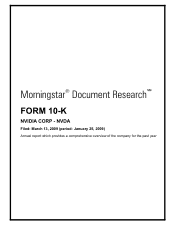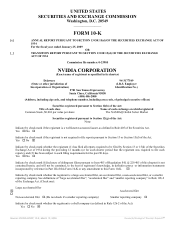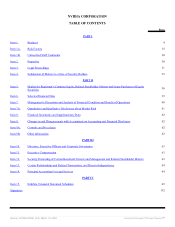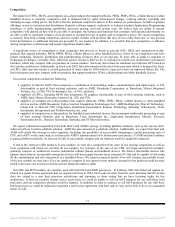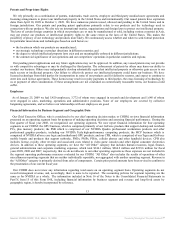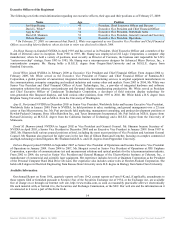NVIDIA 2009 Annual Report Download - page 7
Download and view the complete annual report
Please find page 7 of the 2009 NVIDIA annual report below. You can navigate through the pages in the report by either clicking on the pages listed below, or by using the keyword search tool below to find specific information within the annual report.
We believe that recent years have experienced an increasing level of global adoption for the computer-aided design approach of
product creation. We have achieved a leading position in the professional graphics category by providing innovative GPU technology,
software, and tools that integrate the capabilities of our GPU with a broad array of visualization products.
During fiscal year 2009, we launched several new Quadro solutions. These included the Quadro FX 3600M Professional, which is
among the highest performing notebook GPUs, and the Quadro Plex D Series, a dedicated desk side VCS system that, alternatively,
can be configured using two Quadro Plex D systems for a 3U configuration that fits a standard 19” rack environment. At the
SIGGRAPH 2008 conference, the Quadro Plex D2 system set a new milestone in computer graphics by demonstrating the world’s
first real-time fully-interactive ray tracer. We also launched five new Quadro FX notebook GPUs that spanned from ultra-high
performance to ultra mobility, as well as the Quadro CX, the industry’s first accelerator for Adobe’s Creative Suite 4, or Adobe CS4,
content creation software. Adobe CS4 software has added optimization to take advantage of GPU technology. The Quadro CX is
specifically designed to enhance the performance of the Adobe CS4 product line and to give creative professionals the ultimate
performance and productivity.
During fiscal year 2009, we also we launched the Tesla C1060 computing processor and the Tesla S1070 computing system, which
is among the first teraflop processors and has a 1U system demonstrating up to four teraflops of performance. Tesla is a new family of
GPU computing products that delivers processing capabilities for high-performance computing applications, and marks our entry into
the high-performance computing industry. The Tesla family also consists of the C870 GPU computing processor, the D870 Deskside
Supercomputer and the S870 1U Computing Server. We believe we are in an era of GPU computing, where our CUDA parallel
processing architecture can accelerate compute-intensive applications by significant multiples over that of a central processing unit, or
CPU, alone. NVIDIA CUDA is a general purpose parallel computing architecture that leverages the parallel compute engine in our
graphics processing units to solve many complex computational problems in a fraction of the time required on a CPU. There are
currently over 25,000 developers around the world using CUDA. In order to program using the CUDA architecture, developers can,
today, use C, one of the most widely used high-level programming languages, which can then be run at great performance on a CUDA
enabled processor. We expect other languages to be supported in the future, including FORTRAN and C++.
With CUDA, we are able to speed up general purpose compute-intensive applications like we do for 3D graphics
processing. Developers are able to speed-up algorithms in areas ranging from nano molecular dynamics to image processing, medical
image reconstruction and derivatives modeling for financial risk analysis. Over 100 universities around the world now teach parallel
programming with CUDA and many PC OEMs now offer high performance computing solutions with Tesla for use by customers
around the world, including Motorola, Chevron, GE Health Care and even General Mills, the consumer products company.
Researchers use CUDA to accelerate their time-to-discovery, and popular off-the-shelf software packages are now CUDA accelerated.
MCP Business
Our MCP business is comprised of nForce core logic and GeForce mGPU products. Our nForce and GeForce mGPU families of
products address the core logic market. Core logic is the computer’s “central nervous system,” controlling and directing high speed
data between the central processing unit, or CPU, the GPU, storage, and networks. High quality, long-term reliability, and top
performance are key customer demands of core logic suppliers.
During fiscal year 2008, we announced a new technology named Hybrid SLI. This technology combines the multi-GPU technology
with a powerful and energy-efficient engine. When GeForce add-in graphics cards are connected to GeForce mGPUs, Hybrid SLI
kicks in, combining their processing power to deliver an improved experience. The technology is application aware so, depending on
the processing demands of each application running on the host PC, the discrete GPU may be completely shut down in order to save
power.
During fiscal year 2009, we shipped Hybrid SLI DX10 mGPUs – the GeForce 8000 GPU series. The GeForce 8000 GPU series
includes GeForce Boost Hybrid SLI technology, which is designed to double performance when paired with a GeForce 8 series
desktop GPU. We also extended the reach of SLI technology into the performance category with the launch of our NVIDIA nForce
790i Ultra SLI MCP, a highly rated overclockable platform for Intel Corporation, or Intel, processors. During fiscal year 2009, we
launched the GeForce 9M series of notebook GPUs that enables improved performance in notebooks with Hybrid SLI technology and
PhysX technology. We also launched SLI for Intel Broomfield CPU platforms. When paired with the nForce 200 SLI MCP, Intel’s
Bloomfield CPU and Tylersburg core logic chipset will deliver NVIDIA three-way SLI technology with up to a 2.8 times performance
boost over single graphics card platforms.
In fiscal year 2009, we launched the GeForce 9400M mGPU along with Apple Inc., or Apple, for their new lineup of Mac
notebooks. The GeForce 9400M integrates three complex chips – the northbridge, the input-output network processor, and the
GeForce GPU into a single chip and, as a result, significantly improves performance over Intel integrated graphics. Apple’s MacBook
and MacBook Air notebook computers come standard with the GeForce 9400M. Apple’s MacBook Pro notebook computer comes
standard with the hybrid combination of two GeForce GPUs - a GeForce 9400M for maximum battery life and a GeForce 9600M GT
for high performance mode. We also launched the GeForce 9400 and 9300 mGPUs for Intel desktop PCs. These new mGPUs set a
new price/performance standard for integrated graphics by combining the power of three different chips into one highly compact and
efficient GPU.
6
Source: NVIDIA CORP, 10-K, March 13, 2009 Powered by Morningstar® Document Research℠

